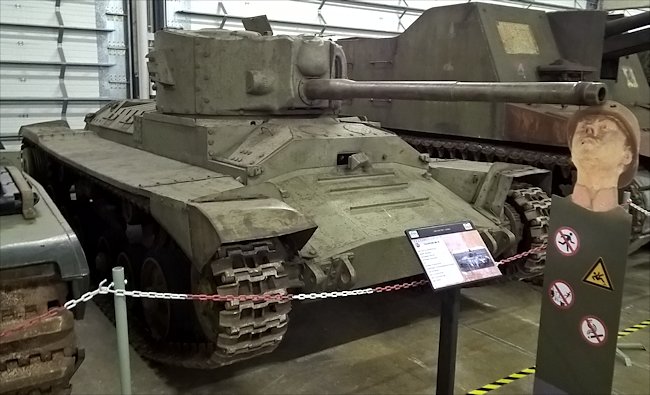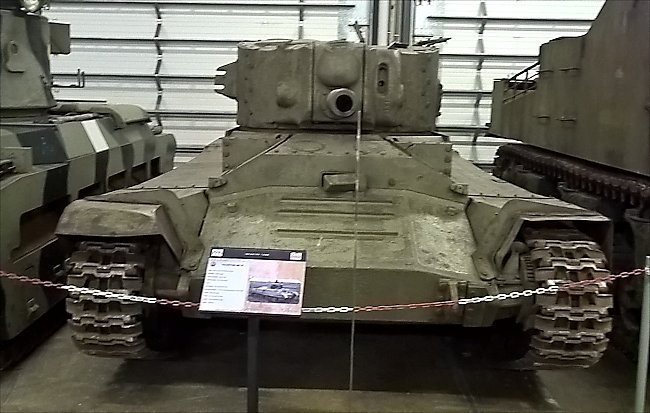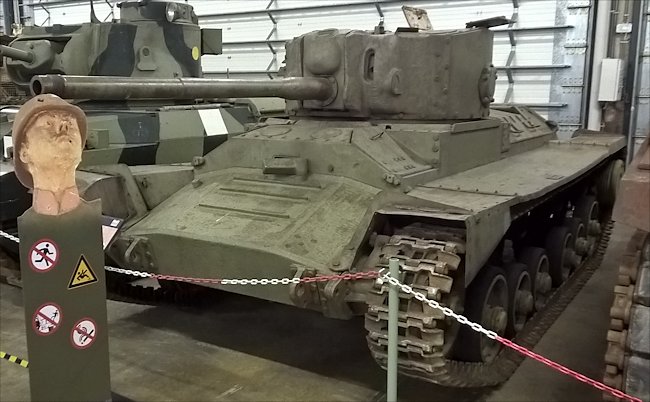British Valentine Mk IX Tank
British Valentine Mk IX Tanks did not see frontline action in the WW2 Battle of the Bulge. They were found to be obsolete after landing in France in 1944. Their 6pdr gun could not penetrate the frontal armour of German tanks. The Valentine Mk IX tanks armour was too thin. They were used for rearguard duties or shipped back to England to be used in training. This surviving Valentine Mk IX Tank is kept at the Bastogne Barracks in Belgium..

This restored British Valentine Mk IX Tank is exhibited at the Bastogne Barracks in Belgium.
Location
The Bastogne Barracks can be found at 40 Rue de la Roche (N834) in Bastogne just north west of the city centre. They open at 10am and close at 4pm. You really need to get there by 2pm as there is a lot to see. It is an operational military camp with a tank restoration centre attached. You have to wait to go on a guided tour. You cannot wander around on your own. The only day it is closed is Monday. Many of the tanks have been restored to running condition. Have a look at their Facebook page for information about new events.

The driver's position was in the middle of the tank on the British Valentine MkIX
Specifications
The Valentine Tank Mk IX was powered by a General Motors 6004 diesel engine that produced 131 hp. On late production units an upgraded, 165 hp version of the GMC 6004 diesel was installed, somewhat improving mobility. It had a top road speed of only 15 mph (24 km/h) and an operational range of around 90 miles (140km) before the tank needed to refuel
It was armed with a British Quick Firing QF 6-pounder (57mm) gun and had a 7.92mm Besa machine gun fitted next to the main gun in the turret. It had a crew of three: Commander, driver and gunner. The tank weighed 16 tonnes. In 1942 when the 6-pdr gun was first introduced It could knock out most German tanks. It even knocked out a tiger tank by hitting its side armour. By 1944 the 6-pdr gun was not powerful enough to penetrate the new breed of heavily armoured German tanks.

This restored British Valentine MkIX Tank is missing its muzzle brake that helped reduce recoil and prolonged the life of the gun barrel.
The Valentine Tanks development
Almost every successful armoured fighting vehicle design demonstrated its versatility by proving capable of being put to a great many more roles than were envisaged in the primary design, and few tanks found so many conversions or fought on a greater variety of fronts in different armies than Valentine Tank.
She was proposed by Vickers to the War Office just before St Valentine's Day in 1938 with a view to producing a heavily armoured tank with some of the characteristics of the A-9 and A-10 cruisers tanks, but with far greater reliability. This is the story that many people believe was how the tank got its name but staff at the Tank Museum in Bovington disagree. They say the name Valentine was a Vickers production code name that stuck.
Wherever possible Vickers used parts that were well tried and easy to manufacture. Manganese steel tracks had a life of 2,500 miles, the suspension was the most successful part of A-9, the AEC engine was that used in the London double-decker buses, and the gun was the standard 40-mm, then in quantity production.
The armour was bolted and riveted together but not set in a frame as had been common Vickers practice up to then. Even so the War Office took its time taking a decision and did not sign a contract for over a year, just on the eve of war, though asking for first delivery in less than a year.
This Vickers achieved without building a prototype, and got away with the risk by a thoroughly sound piece of competitive mechanized engineering. From a crewman's point of view Valentine in its pure tank form provided contrasts in good and bad features. The driver's compartment was cramped and difficult to enter or leave; the steering levers demanded a fair amount of effort to apply and changing gear on the five-speed gearbox, while providing the driver with a sense of personal satisfaction, demanded skill and frequency of operation. This was all rather fatiguing.
The turret was even more cramped than the driver's compartment and, in the early two-man version, posed awkward problems to the commander who had to command, operate the radio, and load the gun. Since vision was extremely limited when closed down, this tank suffered from several fundamental tactical disadvantages. But Valentine was reliable, whether powered with the AEC petrol or diesel engine or the General Motors diesel; the tracks gave next to no trouble and the suspension stood up well when at maximum speed on rough country, though a top speed of 15 mph was hardly compatible with claims to employment in the fast cruiser tank role.
Nevertheless, though Valentine was described as an 'infantry' tank and most frequently employed in this role, it was included in some armoured divisions as a cruiser when, after the severe losses at Dunkirk, British industry could not produce enough tanks of any sort to satisfy demand. Hence the ease with which Valentine could be built was a distinct advantage in 1940 and 1941 when almost any tank to the British was better than none at all.
The same applied when the Germans invaded Russia in 1941 and the latter were in dire need of tank replacements. Valentines were those that Britain sent in greatest number and some of them ,the Russians rearmed with their own guns. Valentine's debut in action, however, came in the Western Desert in 1941 where it performed with credit until it came up against German anti-tank guns with a calibre of 50 mm and upwards. At this time the introduction of a three-man turret, still armed only with a 40-mm gun, corrected the more obvious difficulty of crew control, but when the larger and more powerful 57-mm (and, later still, 75-mm) gun was substituted extra space had to be found by reducing the crew to its original number and, at the same time, making do with less ammunition.
Along with progressive changes in armament, crew layout, and engine there also came a fundamental alteration of the method of construction brought about by the need to make the chassis waterproof for wading. Welding took the place of rivets and bolts along the lower hull seams, and in due course entirely replaced the original jointing throughout the hull.
By the end of 1943 Valentine in its original form, and even when given the 57-mm gun, was passing into obsolescence as more powerful cruisers and the Churchill came into service against German tanks of infinitely greater power. However, uses still had to be found for the hundreds of chassis that remained and for a production line which it would be uneconomic to close down. Quite a number found their way into the service of foreign armies several going to the French army in North Africa for use in the latter stages of the Tunisian campaign. Marks VI and VII (both 40-mm armed two-man types) were built in Canada. A great many more were used to instruct new crews in the art of driving, but the bulk were turned over to special but subsidiary tasks.
Read more in these two tank books

